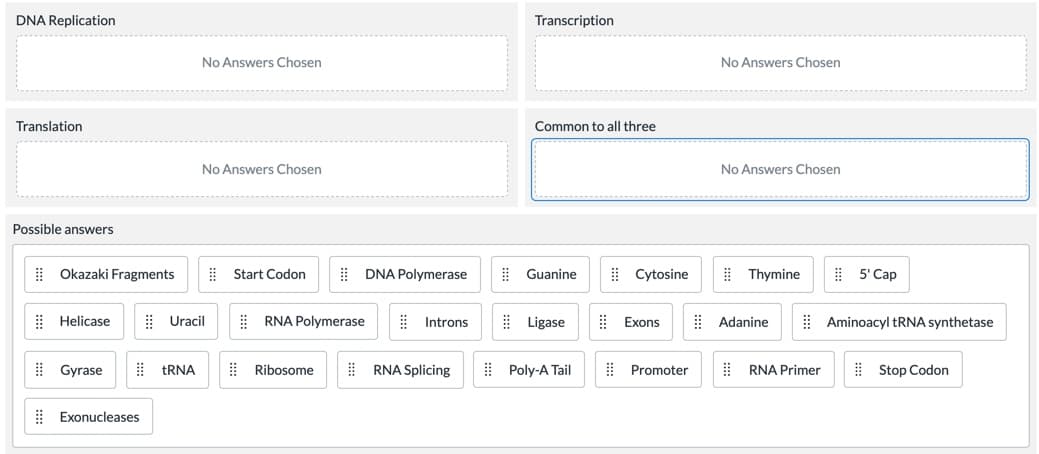DNA Replication Transcription No Answers Chosen No Answers Chosen Translation Common to all three No Answers Chosen No Answers Chosen Possible answers ! Okazaki Fragments E Start Codon | DNA Polymerase ! Guanine | Cytosine | Thymine | 5' Cap ! Helicase | Uracil | RNA Polymerase E Introns | Ligase | Exons | Adanine | Aminoacyl RNA synthetase | Gyrase | TRNA | Ribosome | RNA Splicing | Poly-A Tail I Promoter I RNA Primer I Stop Codon | Exonucleases
DNA Replication Transcription No Answers Chosen No Answers Chosen Translation Common to all three No Answers Chosen No Answers Chosen Possible answers ! Okazaki Fragments E Start Codon | DNA Polymerase ! Guanine | Cytosine | Thymine | 5' Cap ! Helicase | Uracil | RNA Polymerase E Introns | Ligase | Exons | Adanine | Aminoacyl RNA synthetase | Gyrase | TRNA | Ribosome | RNA Splicing | Poly-A Tail I Promoter I RNA Primer I Stop Codon | Exonucleases
Biochemistry
6th Edition
ISBN:9781305577206
Author:Reginald H. Garrett, Charles M. Grisham
Publisher:Reginald H. Garrett, Charles M. Grisham
Chapter28: Dna Metabolism: Replication, Recombination, And Repair
Section: Chapter Questions
Problem 17P
Related questions
Question
1) It asks to categorize and match the "possible answers" as components of translation, transcription, DNA replicaiton or common for all:

Transcribed Image Text:DNA Replication
Transcription
No Answers Chosen
No Answers Chosen
Translation
Common to all three
No Answers Chosen
No Answers Chosen
Possible answers
| Okazaki Fragments
| Start Codon
| DNA Polymerase
E Guanine
| Cytosine
| Thymine
| 5' Cap
| Helicase
| Uracil
E RNA Polymerase
| Ligase
E Exons
E Adanine
| Aminoacyl TRNA synthetase
Introns
| Gyrase
| TRNA
| Ribosome
| RNA Splicing
| Poly-A Tail
| Promoter
| RNA Primer
| Stop Codon
| Exonucleases
Expert Solution
Step 1
The mechanism by which a double-stranded DNA molecule is replicated to create two equivalent DNA molecules is DNA replication. The mechanism of producing an RNA copy of a gene sequence is transcription. This clone, called a molecule of messenger RNA (mRNA), escapes the nucleus of the cell and reaches the cytoplasm, where it guides the protein synthesis it encodes. The translation is the protein synthesis process from the mRNA.
Trending now
This is a popular solution!
Step by step
Solved in 2 steps with 1 images

Knowledge Booster
Learn more about
Need a deep-dive on the concept behind this application? Look no further. Learn more about this topic, biology and related others by exploring similar questions and additional content below.Recommended textbooks for you

Biochemistry
Biochemistry
ISBN:
9781305577206
Author:
Reginald H. Garrett, Charles M. Grisham
Publisher:
Cengage Learning

Human Heredity: Principles and Issues (MindTap Co…
Biology
ISBN:
9781305251052
Author:
Michael Cummings
Publisher:
Cengage Learning

Biochemistry
Biochemistry
ISBN:
9781305577206
Author:
Reginald H. Garrett, Charles M. Grisham
Publisher:
Cengage Learning

Human Heredity: Principles and Issues (MindTap Co…
Biology
ISBN:
9781305251052
Author:
Michael Cummings
Publisher:
Cengage Learning